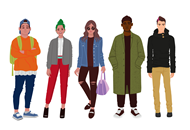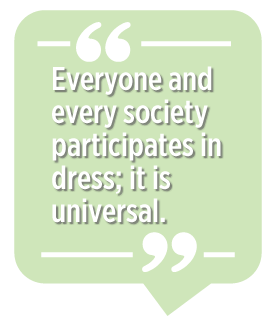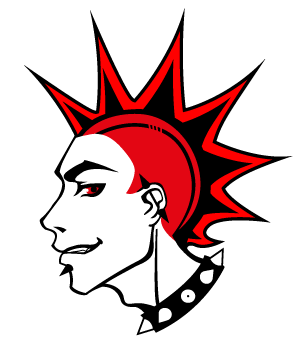Breaking Stereotypes Using the Semiotics of Dress
by Timothy Foran

As an English learner (EL) instructor who primarily focuses
on college-level composition, I am always on the hunt for new and creative ways
to make writing engaging. This is often no easy task, and I am continuously
searching for such activities so that my classroom does not get stale. My goal
here is to share a unique and engaging writing activity that uses the semiotics
of dress to teach ELs description and analysis writing, while also teaching
them about cultural differences, so they can appreciate diversity in the
classroom. Although there are different approaches to semiotics, such as in
structuralism or social semiotics, for the purpose of this brief article, I
refer to the general notion of semiotics— a way to examine signs and symbols
and the construction of meaning.
Dress as a Form of Complex Communication
When most
people think of the word dress, not much comes to mind
other than the clothes they are wearing. However, dress means more than just
clothes. Dress scholars Johnson and Lennon (2015) unravel the complexity of the
term by detailing that dress consists of body modifications (items used to
change the body, e.g., cosmetics and deodorant) and body supplements (items
added to the body, e.g., clothing and jewelry).
 Johnson and
Lennon (2015) further claim that one of the functions of dress is to serve as a
means of communication; however, for this function to work, meaning must be
attached to the items of dress, which allows people to communicate and make
inferences about others. Not only does dress serve as a means of communication,
but also students are naturally drawn to it as everyone and every society
participates in dress; it is universal. Dress, subsequently, serves as a
uniting force in the classroom, but it can also simultaneously separate those
from diverse sociocultural backgrounds because items of dress may carry
different meanings across cultures and countries.
Johnson and
Lennon (2015) further claim that one of the functions of dress is to serve as a
means of communication; however, for this function to work, meaning must be
attached to the items of dress, which allows people to communicate and make
inferences about others. Not only does dress serve as a means of communication,
but also students are naturally drawn to it as everyone and every society
participates in dress; it is universal. Dress, subsequently, serves as a
uniting force in the classroom, but it can also simultaneously separate those
from diverse sociocultural backgrounds because items of dress may carry
different meanings across cultures and countries.
Connecting Semiotics
Although
this article will not discuss semiotics in detail, it is not hard to discern
how items of dress serve as signs. Most, if not all, people utilize items of
dress to convey a message, and others make inferences about that message based
on the items of dress. In fact, it might not be possible to escape this action
because even when individuals want to convey that they are not interested in
fashion, they have to do so by choosing items of dress considered unfashionable
by society.
Berger
(1999) even connects the act of dress to Saussure’s (1966) discussion on speech
and language. As Saussure explains, language is a social institution, and
speech refers to people’s utterances within that institution as people select
words in a language to construct meaning. Similarly, fashion is a social
institution, and the act of choosing items of dress is people’s behavior within
that institution. Berger also explains how dialects—a particular type of
language—are similar to clothing styles—particular ways to arrange items of
dress. Additionally, because people use dress to both communicate and make
inferences about others, dress can also be misunderstood or misinterpreted,
just like speech, especially between members of different sociocultural
communities.
Let’s take a
quick look at a person’s hair to see the various interpretations that can be
made.
|
Signifier |

|
|
Signified |
Denotation |
Connotation |
|
Red spiky hair
with shaved sides |
Punk, counter
culture, rebel, individual, tough, fights, criminal |
Most people will agree that this hair style is
called a mohawk, and this particular one is composed of red spiky hair of
medium length. Depending on their level of vocabulary, ELs will likely have
little difficulty in describing the appearance of this person’s hair; we can
all agree with the denotation.
The miscommunication,
however, might occur when students describe what this mohawk means to them—the
connotation or unpacking of the cultural baggage. When I look at this picture,
I recall fond memories of my youth listening to the Misfits and going to punk
shows with my friends. As such, the mohawk, to me, has positive connotations of
people not conforming to mainstream society and jock culture. Nevertheless,
students can have vastly conflicting thoughts of who this person is and what he
is like based on his mohawk. Students, for example, could argue that the man’s
mohawk suggests that he is a criminal, and students from collective cultures
might see his individualism and rebelliousness as negative traits.
Why Use the Semiotics of Dress?
EL writing
instructors should incorporate the semiotics of dress into the classroom not
only because dress is universal but also because they can capitalize on using
the denotation and connotation to teach descriptive and analysis writing as
well as raising cultural awareness. Additionally, many English language
textbooks tend to focus on denotational meanings, disregard cultural
connotations, and reinforce mainstream cultural ideologies and stereotypes
(Weninger & Kiss, 2013). Instructors, therefore, can use the abundance
of cultural content embedded in the connotations of dress to teach students
about other cultures and subcultures by having them discuss the items people
wear, why they wear them, and what they mean to them.

What follows
is a brief example of how I incorporate the semiotics of dress to teach writing
and cultural awareness. Please note that this particular example is geared
towards ELs in college composition or precomposition/developmental classes;
however, this example can be modified to teach ELs at various levels, including
those who are developing their sentence and paragraph writing skills. As I
teach in a fashion college, my ELs are well versed in fashion and dress
lexicon. If needed, instructors may preteach certain ideas and vocabulary to
prepare their students for this activity, although most of this lesson requires
the students to recall familiar items of dress, analyze them, and teach other
students about them.
Classroom Activity
Step 1: Starting the
Discussion
Have a class
discussion asking the students to describe their favorite clothes, styles, and
brands. Encourage them to explain the why: Why is this their
favorite?
Ask students
to describe the trends in their countries:
-
What is popular and what is not?
-
Why are certain looks “better” than others?
-
Are certain trends popular in one country and unpopular in another?
-
How do they individualize themselves through dress?
-
What does their style say
about them?
Step 2: Describing
(Denotation)
Distribute
the handout (see Appendix, .docx). Direct students to select a picture of a person
from their country or of themselves wearing a popular/favorite clothing
style.
Tell the
students to list all of the individual items of dress in the left column,
titled “Items of Dress.”
Focus
students on composing an objective and detailed description of each item of
dress in the middle column, titled “Description.”
Step 3: Unpacking the
Cultural Baggage (Connotation)
Ask students
to fill out the right column, titled “Meaning,” by thinking about the following
questions:
-
What does each item of dress mean?
-
What does each item of dress say about the person?
-
What would other people in your country assume about this person based on the items of dress?
-
Was this look always
popular? When and why?
Step 4: Writing the
Essay
Inform students
that they will use the handout to write an essay analyzing the picture they
selected. (Review how to conduct an analysis as required.) Use the following
questions to help guide their analysis and form a thesis:
Have the
students use the handout to guide their writing as they support their thesis
statement.
-
Each item of dress can form a paragraph or similar items of dress can be grouped together to form a paragraph.
-
Students can use information in the description column to help them thoroughly describe the items to the audience.
-
They can use the
information in the meaning column to explain what each item means and how it
supports the overall analysis stated in the thesis.
Step 5: Increasing
Cultural Awareness
After
students complete the essay, they will present their analysis to the class.
Have the students display their selected picture. Allow the class to discuss
the picture, explaining what they think of the clothes and what the clothes
mean. Have each student explain their analysis of the picture and
interpretation of the clothing.
To increase
cultural awareness and break stereotypes, facilitate a class discussion around
the differences or similarities noted between the presenter’s analysis and the
students’ impressions of the pictures.
Conclusion
People
construct meaning in various ways, and one of the main ways people do so is by
using dress. Although people perform these personalized acts of dress, the
meaning of these acts is connected to the social institutions within which they
are situated. This can create miscommunication when people, such as ELs, from
varying sociocultural backgrounds attempt to understand dress but do not
understand the connotations attached to the items. Because of sociocultural
differences, students may unknowingly apply stereotypes as they strive to
understand what others are communicating through dress. Rather than being
divisive, teachers, however, can utilize the semiotics of dress to develop ELs’
understandings of people from other sociocultural backgrounds, which will
subsequently break stereotypes.
References
Berger, A.
A. (1999). Signs in contemporary culture.
Sheffield.
Johnson, K.,
& Lennon, S. (2015). The social psychology of dress.Bloomsbury Fashion Central, 1–7.
http://dx.doi.org/10.5040/9781474280655-BG001
Saussure, F.
(1966). Course in general linguistics. McGraw Hill.
Weninger, C., & Kiss, T.
(2013). Culture in English as a foreign language (EFL) textbooks: A semiotic
approach. TESOL Quarterly, 47,
694–716. https://doi.org/10.1002/tesq.87
Timothy Foran is the assistant director of the Writing Center at LIM College in New York City, where he specializes in English language education. He earned his MA in TESOL at the University of Mississippi and is currently working on his PhD in literacy at the University at Albany.